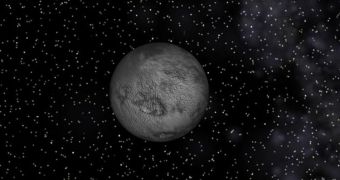When the dwarf planet 2007 OR10 was discovered four years ago, experts nicknamed it Snow White due to the fact that it has an icy surface. Now, investigators in the United States determined that the small trans-Neptunian object is also covered in a very thin film of methane.
Astronomers based at the California Institute of Technology (Caltech) say that this thin layer of the gas is everything that remains of the space body's atmosphere. Slowly, its gases are trickling into deep space, leaving the object's surface bare and exposed.
When viewed through telescopes, only half of Snow White's surface is covered with ices. Astronomers believe that the chemical was produced from ancient volcanoes that were once active on the surface. These geological formation spewed slush rather than lava.
This object was discovered back in 2007, as part of the PhD thesis of Meg Schwamb, a former graduate student at the Brown University. It is the fifth largest dwarf planet in our solar system, featuring a diameter half that of Pluto.
At first, experts proposed that the object was in fact a large piece of debris ejected from the known dwarf planet Haumea, following a violent collision. However, subsequent observations proved that Snow White formed onto itself.
“You get to see this nice picture of what once was an active little world with water volcanoes and an atmosphere, and it's now just frozen, dead, with an atmosphere that's slowly slipping away,” researcher and astronomer Mike Brown explains.
He holds an appointment as the Caltech Richard and Barbara Rosenberg professor and professor of planetary astronomy. The expert was also the lead author of a new paper detailing the findings, which will appear in the upcoming issue of the esteemed Astrophysical Journal Letters.
“With all of the dwarf planets that are this big, there's something interesting about them—they always tell us something. This one frustrated us for years because we didn't know what it was telling us,” Brown says of the challenges associated with studying this world.
Recently, after astronomers contacted chemists for help, the riddle of why Snow White appeared to have a reddish tint was unlocked. It would appear that the secret lies within the methane gas that still lingers close to the object's surface.
Methane is a compound featuring a carbon atom linked to four hydrogen atoms. When exposed to intense sunlight and radiation from the Sun, these molecules form long chains that may permeate the ice. In this configuration, the chemical appear red, which explain the tint astronomer saw on the body.

 14 DAY TRIAL //
14 DAY TRIAL //